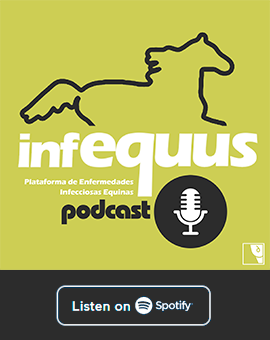Equine influenza
Etiology
Influenza A virus (Orthomyxoviridae family). ARN virus. Influenza A viruses causing equine influenza are H7N7 (A/equine/1) and H3N8 (A/equine/2). H7N7 viruses have not been detected in the equine population since 1970, while H3N8 have evolved and diverged into two lineages, Eurasian and American. Within the American lineage (prevailing) there are three sublineages: South American, Kentucky and Florida; in the latter the prevailing viruses in the present equine population worldwide (Clade 1 and Clade 2) can be found.
Epidemiology
Influenza virus affects all ages and breeds of Equidae, although it is more common in young horses without a history of prior vacccination. The virus has a short incubation period, the horses start showing fever and shedding large quantities of virus in nasal secretions within 48 hours of the infection. Secondary bacterial infections are frequent. Morbidity rates can vary from 20% to 90%, with mortality rates lower than 1%. Outbreaks can occur at any time of the year, although seasonal outbreaks have been reported, linked to the convergence of risk factors (horse congregations, cold weather, etc.). The infection is caused by direct contact with infected horses or nasal secretions (contagious droplets in the cough) and via respiratory. The virus has the capacity of surviving in humid environments for 72 hours and in dry environments for 48 hours. After the infection, horses shed virus for 6-7 days. Horses with partial immunity can have a subclinical infection and shed virus.
Pathogeny
The virus replicates and induces pathologic changes in respiratory epithelial cells. After the exposure, the infection starts with the binding of the viral Hemaglutinin to sialic acid residues in the upper respiratory epithelial cells. The virion penetrates the mucus layer over the cell surface and the Neuraminidase destroys mucous glycoproteins in the membrane in order to gain access to the cell, where replication starts. The virus spreads quickly through the respiratory tract, damaging the epitelial cells and causing focal erosions in trachea and bronchi. After 3-5 days post-infection the epithelial regeneration starts, ending after a minimum of 3 weeks.
Clinical signs
Fever is tipically the first clinical sign, with horses showing temperatures up to 41ºC and with a peak 48-96 hours post-infection. A second fever peak can occur after 7 days. Horses show nasal discharge (initially serous turning mucopurulent at 72-96 hours post-infection) together with paroxysmal cough and retropharyngeal limphadenopathy and tachipnea. Some horses can show anorexia that resolves in 1-2 days and can cause an associated weight loss. Clinical signs resolve in 7-14 days in cases without complications, although cough can last for 21 days. Cases that persist in time are due to pneumonia which can result from the secondary infection with bacteria.
Diagnosis
Clinical diagnosis is based on the appearance of respiratory signs in young horses that spread quickly, with dry cough. However, ideally the diagnosis should be carried out in the laboratory by using direct techniques: viral isolation (from a nasopharyngeal swab in the first 24-48 hours of clinical signs), direct nucleoprotein (NP) ELISA (in a nasopharyngeal swab), direct immunofluorescence (in cells from nasopharynx or a tracheal wash), RT-PCR (in a nasopharyngeal swab) and also indirect techniques (in serum): hemagglutination inhibition, single radial hemolysis, and ELISA. Carrying out pathology is not common due to the low mortality rates; when done an inflammation of the nasal, pharyngeal, laryngeal and tracheal mucosa, as well as changes in the lungs (bronchitis, peribronchitis, perivasculitis with interstitial pneumonia, edema and focal bronchopneumonia) has been observed. Occasionally there is miocarditis. Neonatal infection can lead to a severe and fatal bronchointerstitial pneumonia. Hemogram findings include a moderate normocytic, normochromic anemia with leukopenia (which results from neutropenia and lymphopenia) of 3 to 5 days´ duration and a monocytosis in the convalescent phase.
Treatment
Treatment includes resting and administration of support treatment (Nonsteroidal anti-inflammatory drugs, antibiotics if there is pneumonia due to secondary bacterial infection)
Treatment with antivirals (blockers of the M2 ionic chanel – amantadine and rimantadine – and neuraminidase inhibitors – zanamivir and oseltamivir) is controversial since it causes resistencies.
Prevention and control
Vaccination against Equine Influenza is essential for the control of the disease. The most common vaccines are inactivated, although there are also modified live vaccines and recombinant vaccines. It is very important to apply vaccines which are up to date, following the recommendations from the OIE expert panel. This panel updates the recommendations every year depending on the circulating strains of the virus. The general recommendation is to vaccinate foals after 6 months of age, pregnant mares 2 to 6 weeks before partum with inactivated vaccines, and in general a primovaccination is carried out with a dose of the vaccine, second booster at 3-4 weeks after and a third booster 3-4 months later, with a revaccination every 6 months in horses that compete or horses at high risk. Regarding prevention measures in horse premises, horses without a history of vaccination that arrive at a premises should be isolated for at least 4 weeks. During the quarantine, these horses should undergo a primovaccination. Also, in high risk horse premises, young horses should be separated from other horses, and horses should be grouped in small groups in order to avoid the quick spread of disease in case of an outbreak.
Public Health Considerations
Influenza A viruses have a partial host restriction; that is, they can be transmitted to other species occasionally. H3N8 outbreaks have been confirmed in dogs, transmitted from horses, and vice-versa. However, there have been no cases of H3N8 in humans. Equine Influenza is a disease included in the OIE list, and as such it is mandatory to declare it in Spain.
References
- http://www.oie.int/doc/ged/D14002.PDF
- http://wahis2-devt.oie.int/fileadmin/Home/esp/Health_standards/tahm/2.05.07.%20Gripe%20equina.pdf
- http://www.oie.int/fileadmin/Home/esp/Health_standards/tahm/2.05.07_Gripe_equina_a.pdf
- http://www.oie.int/es/nuestra-experiencia-cientifica/informaciones-especificas-y-recomendaciones/gripe-equina/

